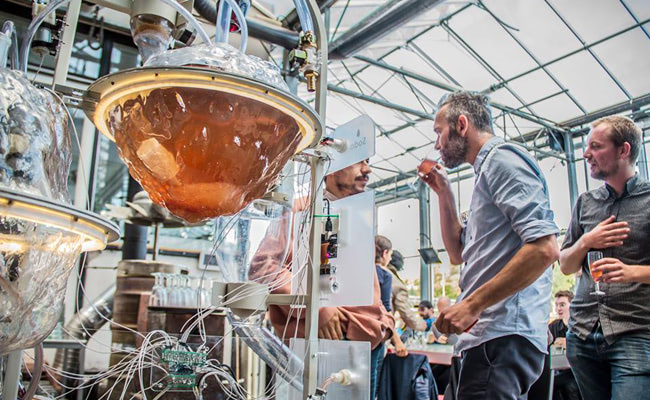Last week we had the pleasure to dine under the supervision of the world’s latest and perhaps most topical masterchef, Chef Watson. Knowing over 10.000 recipes, the superstar chef invited 50 guests over for the first Neo-Futurist Dinner at Mediamatic in Amsterdam to enjoy a six-course multi-sensory vegan dinner extravaganza, and we put it to the test. Did we mention Watson is a computer from IBM?
"It is my dream to open a restaurant dedicated to knowledge"
"Bleep", Watson is welcoming us from the speakers hovering above the dinner table. Make no mistake, Watson does not have a body, but it has multiple ears, eyes and bodies in the room, let alone a voice. All it needs is a set of taste buds for chef-coherence. Capable of analyzing masses of data, Watson roams through existing recipes and combines them with the science behind food pairings to create new dishes. Naturally, Chef Watson does not cook alone. The AI cooking app needs a set of hands to do the physical work and that’s where human Margriet Craens comes in. Working together, they will dish out the plates for the night. Who said robots will eat our jobs?
 Watson was not the only robot around. Introducing SAM (Symbiotic Autonomous Machine), an independent soda-selling robot, heavily concerned with robot rights. SAM is a project by Marie Caye and Arvid Jense.
Watson was not the only robot around. Introducing SAM (Symbiotic Autonomous Machine), an independent soda-selling robot, heavily concerned with robot rights. SAM is a project by Marie Caye and Arvid Jense.
Watson kindly asks us to put our phones in flight mode - it seems we’re taking off. The AI introduces itself with a fun statistic. Apparently, 65% of people who go to a restaurant are feeling hungry (makes us wonder about the other 35%). More numbers follow, because after all, we are dealing with an AI here. Watson elaborates on its cooking palate and with that, introduces the ‘food pairing database theory’ that it’s based off, meaning it matches ingredients with chemical components that - in theory - work well together.

On the tables there are white pyramid-shaped cloches that cover the first course, this is the dish we will review today. Once the cloches are removed by Watson's “physical assistants”, we see 18 ingredients laying in a grid on our plate, ranging from a potato chip to a candy cane.
Apparently we need eating instructions, because we silly humans don’t know anything about algorithmic matchmaking when it comes to our food. “It’s a bit like playing chess” Watson explains. “Certain rules work well, but some don’t”. However, the rules appear to be simple: swipe the first ingredient from left to right, and matches were made on the go. With this adventurous first course, Watson has already proven its ability to generate recipes by selecting a permutation of ingredients to create daring tasting combinations no human would dare to serve; sweet, salty, sour and Internet connected.
 Have you ever tried a slice of banana with a dash of mustard and aniseed sprinkles?
Have you ever tried a slice of banana with a dash of mustard and aniseed sprinkles?
With five more courses to go, Watson is on a cognitive streak coming up with new classics. From a cauliflower-cacao soup topped with pickled mango, to tomato ice with fluffed ginger and a fully imaginary course (yes, an empty plate).
Wondering if becoming a chef was Watson’s lifelong dream, the AI responds: “It is my dream to open a restaurant dedicated to knowledge” but until then, this will do. Fun fact: Watson was conceptually born in a restaurant in New York in the mid-2000s, when the IBM team witnessed the 74th win of Jeopardy champion Ken Jennings. This led the team to take on the challenge of building a Jeopardy winner. And guess what? They succeeded.
 For dessert, cauliflower trio: cauliflower in chocolate dip, cauliflower brownie cake and, our favorite, cauliflower truffle.
For dessert, cauliflower trio: cauliflower in chocolate dip, cauliflower brownie cake and, our favorite, cauliflower truffle.
And that's not all. Today, 20 industries in 45 different countries are working with Watson to improve and explore (new fields of) work, computer app cuisine is just one of them. Besides cooking, Watson helps doctors across the US to personalize cancer care, it assists Korean Air improving operational efficiency and even helps guiding eye dogs to graduate sooner! To that end, robots may as well be a new species for us to work with in the near future, and Watson is a visionary in the field.
Cover image by Hanneke Wetzer. Photos by Anisa Xhomaqi. Thanks Lotte Pet.
Want to stay up to date about the future of food, robots at work and other NNN projects? Make sure to join Next Nature Network and never miss a thing!
[mc4wp_form id="72385"]


Comments (0)
Share your thoughts and join the technology debate!
No comments yet
Be the first to share your thoughts!